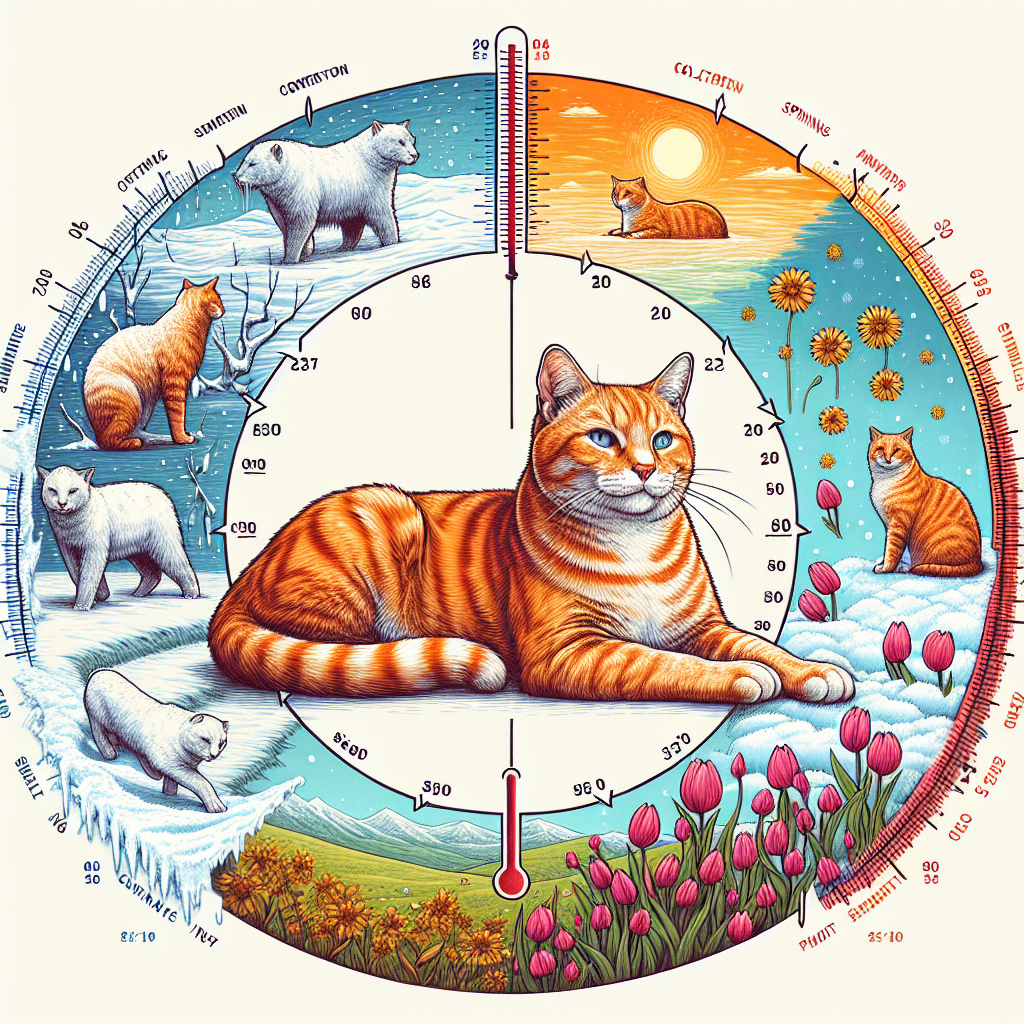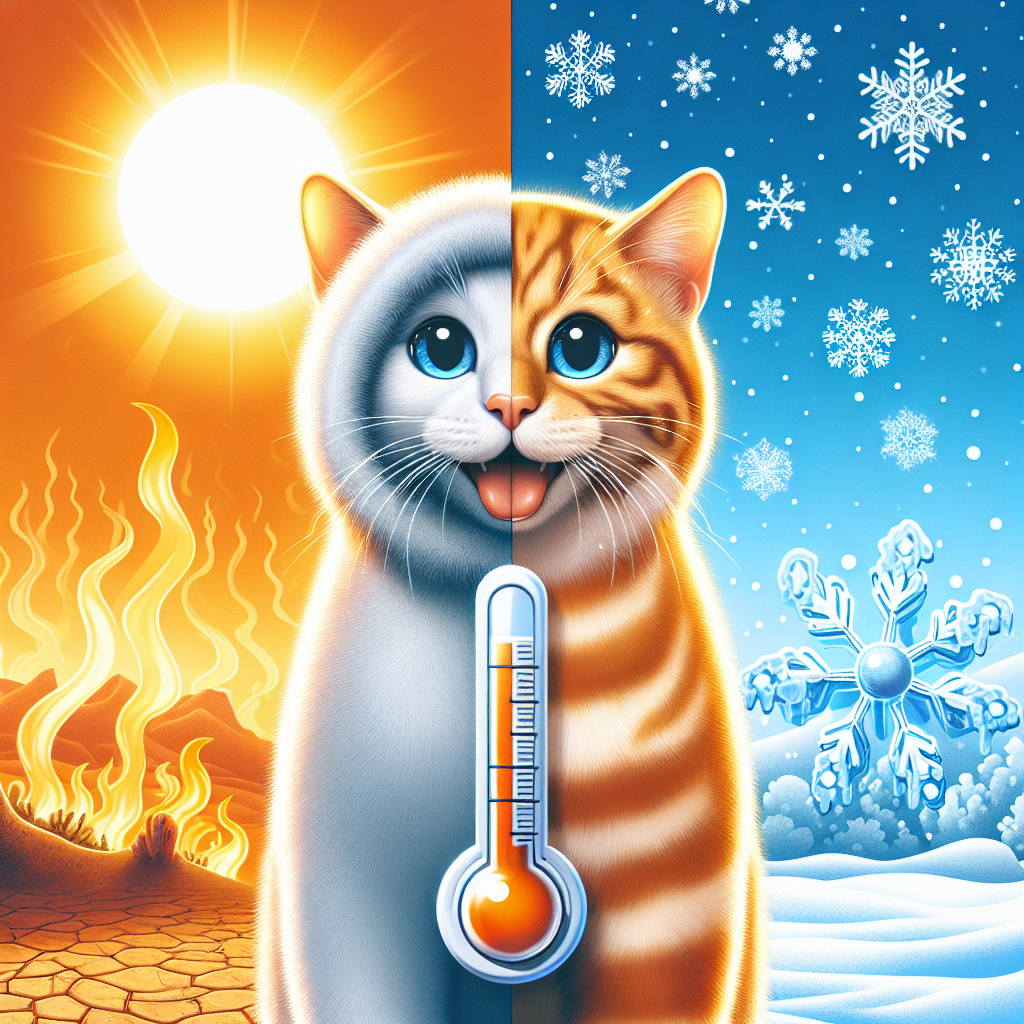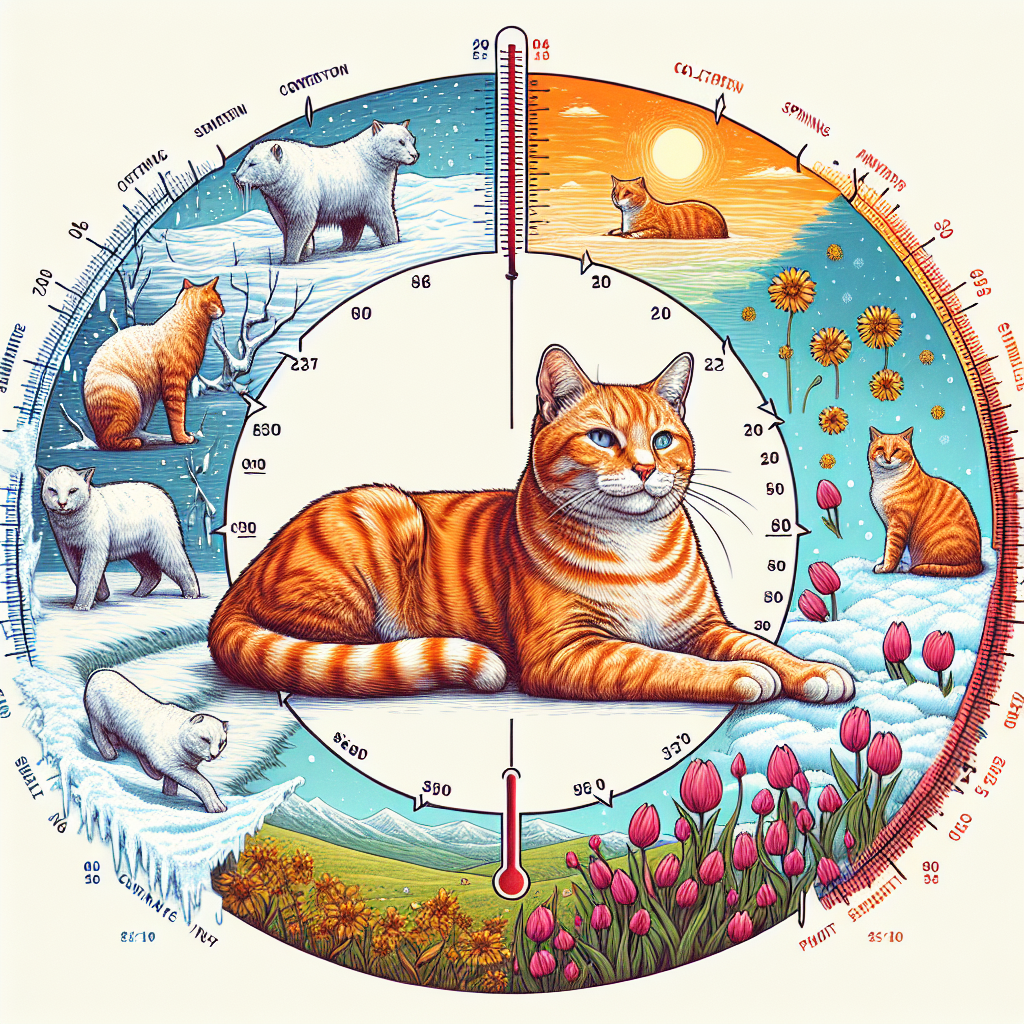Are you curious about the temperature range of an orange tabby cat? Whether you are a proud owner of an orange tabby or simply a cat enthusiast, understanding their preferred temperature range is essential for ensuring their comfort. Cats, including orange tabbies, are known for being highly sensitive to temperature changes. While their ideal temperature range may vary slightly depending on individual preferences, it is generally recommended to keep these adorable felines in a cozy environment with temperatures ranging between 68-78°F (20-25°C) to keep them feeling warm and content. So, next time you snuggle up with your orange tabby, make sure the temperature is just right!

The Temperature Range of an Orange Tabby Cat
Understanding the Temperature Regulation of Cats
As a cat owner, it’s important to understand how your furry friend regulates their body temperature. Cats, including orange tabby cats, are known for being independent and self-sufficient creatures. One crucial aspect of their well-being is maintaining a stable body temperature. Unlike humans who have a constant body temperature of around 98.6°F (37°C), cats have a slightly higher average body temperature ranging from 100.5°F to 102.5°F (38°C to 39.2°C).
Factors Affecting the Body Temperature of Orange Tabby Cats
Several factors can influence the body temperature of orange tabby cats. First, individual cats may have slight variations in their normal temperature range due to factors such as age, health, and activity level. Additionally, external environmental conditions play a significant role in a cat’s body temperature. The ambient temperature, humidity, and exposure to sunlight can all impact how a cat regulates its body heat. It’s important to consider these factors when creating a comfortable environment for your orange tabby cat.
Normal Body Temperature of Orange Tabby Cats
Average Body Temperature
The average body temperature of an orange tabby cat falls within the range of 100.5°F to 102.5°F (38°C to 39.2°C). This range is slightly higher than that of humans, which is why cats generally feel warm to the touch. It’s important to know your cat’s average body temperature so that you can recognize any significant deviations from their norm.
Temperature Range
While the average body temperature range remains relatively constant, there can be slight variations among individual orange tabby cats. Some cats may have a slightly higher or lower baseline body temperature. These variations are usually within a degree or two and are considered normal. However, any drastic or consistent deviations from the average range should be evaluated by a veterinarian.
Variations in Body Temperature
Factors such as age, health conditions, and physical activity can cause temporary fluctuations in a cat’s body temperature. Young kittens and older cats may have more difficulty regulating their body heat, making it essential to provide them with an appropriate environment. Inactivity or excessive physical exertion can also affect the body temperature of your orange tabby cat. Keep an eye on your cat’s activity level and ensure they have access to a comfortable and temperature-appropriate environment.
Effects of Environmental Temperature on Orange Tabby Cats
Thermoregulation in Cats
Cats have an incredible ability to adapt to various environmental temperatures and maintain their body temperature within a comfortable range. This process is known as thermoregulation. Cats have a higher metabolic rate compared to humans, aiding in their ability to generate heat. Additionally, they have specialized sweat glands in their paw pads, which helps cool them down through evaporation. Cats also have a thick fur coat that insulates their bodies and helps retain heat during colder temperatures.
How Heat Affects Orange Tabby Cats
While cats are well-equipped to handle colder temperatures, they are more sensitive to heat. Orange tabby cats, like other felines, do not sweat in the same way humans do. They rely on panting and seeking cooler areas to regulate their body temperature when it gets too hot. If the environmental temperature exceeds their ability to cool down naturally, they can be at risk of heatstroke, which is a life-threatening condition. It’s crucial to provide your orange tabby cat with a cool and well-ventilated space during hot weather to prevent overheating.
How Cold Affects Orange Tabby Cats
Orange tabby cats have a thick fur coat that provides insulation against the cold. However, extreme cold temperatures can still pose risks. Cats can experience discomfort, stiffness, and even hypothermia in frigid conditions. It’s important to create a warm and sheltered environment for your orange tabby cat during the cold winter months. Providing cozy bedding, a draft-free space, and access to warm areas indoors can help prevent the negative effects of cold temperatures.
Determining the Ideal Temperature Range for Orange Tabby Cats
Providing Optimal Room Temperature
Maintaining a comfortable room temperature is essential for the well-being of your orange tabby cat. The ideal room temperature for cats generally falls within the range of 68°F to 78°F (20°C to 25°C). However, it’s important to consider individual preferences and factors like age, health conditions, and seasonality. Some cats may prefer slightly warmer or cooler temperatures within this range. Monitor your cat’s behavior and adjust the thermostat accordingly to ensure their comfort.
Creating a Comfortable Environment
In addition to the room temperature, there are other ways to create a comfortable environment for your orange tabby cat. Ensure that their sleeping area is well-insulated and away from any drafts. Offer cozy bedding, such as blankets or heated pads designed specifically for cats, especially during colder months. Consider providing your cat with access to sunny spots where they can bask in the natural warmth. You can also use fans or air conditioning in hot weather to help keep the temperature within a comfortable range.
Avoiding Extreme Temperatures
Extreme temperatures, whether hot or cold, can pose risks to the health and well-being of your orange tabby cat. Avoid exposing your cat to drastic temperature changes, such as leaving them outdoors for extended periods during severe weather conditions. When traveling with your cat, ensure that the vehicle is climate-controlled. Be mindful of the surfaces your cat comes into contact with, as pavement or metal can become dangerously hot or cold. By taking precautions and considering your cat’s comfort, you can minimize the risks associated with extreme temperatures.

Common Signs of Temperature Discomfort in Orange Tabby Cats
Signs of Overheating
It’s important to be aware of the signs of overheating in your orange tabby cat. Excessive panting, drooling, lethargy, increased heart rate, and warm ears are all indications that your cat may be overheated. They may seek cool areas such as tiles or shade and show signs of distress or agitation. If you notice any of these symptoms, move your cat to a cooler environment, offer fresh water, and contact your veterinarian if the symptoms persist or worsen.
Signs of Hypothermia
Hypothermia occurs when a cat’s body temperature drops below their normal range. Orange tabby cats are particularly susceptible to this condition in cold weather. Some signs of hypothermia include shivering, pale or bluish gums, weak pulse, lethargy, and difficulty walking. If you suspect your cat is experiencing hypothermia, wrap them in warm blankets and contact your veterinarian immediately. Never use direct heat sources like heating pads or hairdryers, as they can cause burns.
Behavioral Changes in Response to Temperature
Pay attention to your orange tabby cat’s behavior as it can provide valuable insight into their comfort level. Cats may seek out warm spots or curl up tightly to conserve body heat when they’re cold. They may also become more vocal or restless in an attempt to communicate their discomfort. Conversely, when cats are too hot, they may become inactive, seek cooler areas, or show signs of irritability. By observing your cat’s behavior and understanding their temperature-related cues, you can enhance their comfort and well-being.
Tips for Managing Temperature and Keeping Orange Tabby Cats Comfortable
Adjusting the Indoor Temperature
To maintain a comfortable temperature for your orange tabby cat, adjusting the thermostat in your home is a simple yet effective solution. Keep the ambient temperature within the ideal range of 68°F to 78°F (20°C to 25°C). Optimal temperature not only ensures your cat’s comfort, but it can also promote better sleep quality and overall well-being. Consider installing a programmable thermostat to regulate the temperature automatically, especially if you are away from home for extended periods.
Using Climate-Controlled Beds or Pads
Cats love warm and cozy resting spots. Consider providing your orange tabby cat with a climate-controlled bed or heating pad designed specifically for pets. These beds or pads have adjustable temperature settings and features that ensure safe and reliable warmth for your cat. Ensure that the temperature is set at a comfortable level and that there are no cords or heating elements accessible to your cat, reducing the risk of injury or burns.
Providing Adequate Shelter for Outdoor Cats
If your orange tabby cat spends time outdoors, it’s crucial to provide them with appropriate shelter. Outdoor cats are more exposed to extreme temperatures, making a well-insulated shelter a necessity. The shelter should be elevated from the ground, waterproof, and provide added warmth through insulation and bedding. Additionally, consider providing outdoor cats with heated water bowls to prevent their water from freezing in colder temperatures. Regularly check the shelter and make any necessary adjustments to ensure a safe and comfortable environment for your cat.
Health Implications of Temperature Extremes for Orange Tabby Cats
Hyperthermia (Heat Stroke) in Cats
Heat stroke, also known as hyperthermia, is a severe condition that can occur when a cat’s body temperature rises to dangerous levels. Orange tabby cats are at a higher risk of heat stroke due to their sensitivity to heat. Heat stroke can lead to organ damage, seizures, and even death if left untreated. It’s crucial to act quickly if you suspect your cat is experiencing heat stroke. Move them to a cool area, offer water, and seek immediate veterinary attention. Prevention, such as providing shade and cool areas, is key in avoiding this potentially fatal condition.
Hypothermia in Cats
Just as orange tabby cats are susceptible to heat-related issues, they are equally vulnerable to the effects of cold temperatures. Hypothermia occurs when a cat’s body temperature drops below the average range, potentially causing serious health problems. It’s important to be aware of the signs of hypothermia and take immediate action if your cat shows any symptoms. Safely warm your cat with blankets and seek veterinary care promptly to prevent further complications.
Impacts on the Immune System
Extreme temperatures, whether hot or cold, can take a toll on your orange tabby cat’s immune system. Prolonged exposure to uncomfortable temperatures can weaken your cat’s immune response, making them more susceptible to infections and illnesses. By providing an environment within the ideal temperature range and taking proactive measures to ensure their comfort, you can support your cat’s immune system and overall health.
Guidelines for Caring for Orange Tabby Cats in Different Seasons
Summer Care Tips
To ensure your orange tabby cat stays comfortable and safe during the summer months, follow these tips:
- Provide shade: Create shaded areas in your yard or on your patio where your cat can retreat to when it gets too hot.
- Fresh water: Ensure your cat has access to clean and fresh water at all times. Consider using water fountains or placing multiple water bowls around the house.
- Avoid hot surfaces: Avoid letting your cat walk on hot surfaces such as pavement or metal, as they can burn their paw pads.
- Indoor retreat: Create a cool and well-ventilated indoor space for your cat to escape the heat. Use fans or air conditioning to keep the temperature moderate.
- Grooming: Help your orange tabby cat stay cool by regularly grooming their fur. Brushing them helps remove excess fur and prevents matting, allowing for better air circulation around their body.
Winter Care Tips
To ensure your orange tabby cat stays warm and comfortable during the winter months, follow these tips:
- Shelter: Provide a warm and insulated shelter for your outdoor cat. Ensure it is weatherproof and raised off the ground to prevent drafts and maintain warmth.
- Indoor comfort: Create warm areas indoors for your cat by providing cozy bedding, blankets, and access to sunny spots. Consider using heated pads or beds designed for cats but ensure they are safe and not overheating.
- Draft-free space: Keep your cat’s indoor space draft-free to prevent cold air from entering. Close any gaps, use door draft stoppers, and keep windows properly sealed.
- Protect paws: Invest in booties or paw wax to protect your cat’s paws from ice, salt, or other harmful substances they may encounter during walks or outdoor adventures.
- Extra calories: During colder months, your cat may require a slightly higher calorie intake to generate more body heat. Consult with your veterinarian to ensure their diet is appropriate and to prevent weight gain.
Transitioning between Seasons
Orange tabby cats, like all cats, require a gradual transition as the seasons change to adapt to new temperature ranges. Gradually adjust the indoor temperature to match the changing weather to allow your cat to adjust without sudden temperature shifts. Observe your cat’s behavior and make adjustments accordingly to ensure their comfort throughout the year.
The Importance of Regular Veterinary Check-ups for Orange Tabby Cats
Monitoring Overall Health
Regular veterinary check-ups are essential for ensuring the overall health and well-being of your orange tabby cat. During these visits, your veterinarian will assess your cat’s temperature, among other vital signs, to detect any abnormalities. They will also perform a comprehensive physical examination, allowing them to identify potential health issues early on. By monitoring your cat’s health regularly, you can address any temperature-related concerns promptly.
Identifying Temperature-related Issues
As part of a thorough examination, veterinarians can identify temperature-related issues that may go unnoticed by cat owners. They have the expertise to detect signs of overheating or hypothermia and assess the severity of the condition. Additionally, they can provide guidance on managing your cat’s temperature and address any underlying health concerns that may contribute to temperature regulation difficulties.
Preventive Measures and Vaccinations
Routine veterinary check-ups also afford the opportunity to discuss preventive measures and vaccinations specific to your orange tabby cat’s needs. Vaccinations can protect your cat from infectious diseases that may compromise their immune system, making them more vulnerable to temperature extremes. Your veterinarian can recommend the appropriate vaccinations and discuss ways to ensure your cat’s immune system remains strong.
Conclusion
Understanding and meeting the temperature needs of your orange tabby cat is essential for their overall comfort and well-being. Cats, like humans, have a narrow temperature range within which they can thrive. By providing optimal room temperature, creating a comfortable environment, and recognizing signs of temperature discomfort, you can help your orange tabby cat stay content and healthy. Regular veterinary check-ups and preventive care play a crucial role in ensuring that your cat remains happy and free from temperature-related issues. The bond you share with your orange tabby cat can be strengthened through your knowledge and commitment to their temperature needs.

